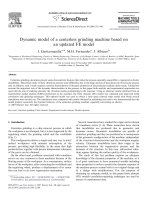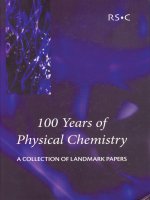Cairns essentials of pharmaceutical chemistry 3e (RPS, 2008)
Bạn đang xem bản rút gọn của tài liệu. Xem và tải ngay bản đầy đủ của tài liệu tại đây (3.41 MB, 297 trang )
:hhZci^Vahd[
E]VgbVXZji^XVa8]Zb^hign
I]^gYZY^i^dc
9dcVaY8V^gch
Essentials of Pharmaceutical
ChemistryEssentials of
Pharmaceutical Chemistry
Third edition
Donald Cairns
BSc, PhD, CSci, CChem, MRPharmS, MRSC
Associate Head of School of Pharmacy
The Robert Gordon University
Aberdeen, UK
London • Chicago
Published by the Pharmaceutical Press
An imprint of RPS Publishing
1 Lambeth High Street, London SE1 7JN, UK
100 South Atkinson Road, Suite 200, Grayslake, IL 60030–7820, USA
© Pharmaceutical Press 2008
is a trade mark of Pharmaceutical Press
First edition published 2000
Second edition published 2003
Third edition published 2008
Typeset by J&L Composition, Filey, North Yorkshire
Printed in Great Britain by TJ International, Padstow, Cornwall
ISBN 978 0 85369 745 9
All rights reserved. No part of this publication may be reproduced, stored in a
retrieval system, or transmitted in any form or by any means, without the prior
written permission of the copyright holder.
The publisher makes no representation, express or implied, with regard to the
accuracy of the information contained in this book and cannot accept any legal
responsibility or liability for any errors or omissions that may be made.
The right of Donald Cairns to be identified as the author of this work has been
asserted by him in accordance with the Coypright, Designs and Patents Act, 1988.
A catalogue record for this book is available from the British Library
For Elaine, Andrew and Mairi
Preface to the third edition
xi
Acknowledgements
xiii
About the author
xv
1 Chemistry of acids and bases 1
Dissociation of weak acids and bases 3
Hydrolysis of salts 9
Amphiprotic salts 11
Buffer solutions 11
Buffer capacity 14
Biological buffers 16
Ionisation of drugs 19
p
K
a
values of drug molecules 20
pH indicators 20
Tutorial examples 23
Problems 28
2 Partition coefficient and biopharmacy 29
Experimental measurement of partition coefficient 33
Drug absorption, distribution and bioavailability 36
Passive diffusion 39
The pH partition hypothesis 40
Active transport mechanisms 44
The action of local anaesthetics 45
Excretion and reabsorption of drugs 48
Food and drink 50
Tutorial examples 51
Problems 56
3 Physicochemical properties of drugs 59
Carboxylic acids 59
Phenols 63
Warfarin 64
Phenylbutazone 67
Indometacin 67
Barbiturates 67
Phenytoin 69
Sulfonamides 69
Basic drugs 71
Basicity of heterocyclic compounds 73
Separation of mixtures 73
Tutorial examples 75
Problems 79
4 Stereochemistry 83
Polarimetry 84
Biological systems 88
Fischer projections 89
Stereochemistry case study: thalidomide 97
Geometrical isomerism 99
Tutorial examples 101
Problems 103
5 Drug metabolism 105
Metabolic pathways 106
Cytochromes P450 107
Enzyme induction and inhibition 111
Drug conjugation reactions (Phase 2) 112
Stereochemistry 119
Metabolic pathways for common drugs 120
Tutorial example 128
Problems 130
6 Volumetric analysis of drugs 133
Volumetric flask 134
Pipette 134
Burettes 135
Units of concentration 135
viii Contents
Concentration of active ingredients 138
Design of an assay 138
Practical points 141
Back and blank titrations 144
Assay of unit-dose medicines 147
Non-aqueous titrations 149
REDOX titrations 150
Compleximetric titrations 152
Argentimetric titrations 154
Limit tests 154
Problems 155
7 Analytical spectroscopy 159
Effect of pH on spectra 164
Instrumentation 168
Experimental measurement of absorbance 170
Dilutions 171
Quantitative aspects of spectroscopy 172
Beer’s and Lambert’s laws 173
Methods of drug assay 175
Derivative spectroscopy 177
Infrared spectroscopy 179
Fluorimetry 182
Structure elucidation 183
Tutorial examples 193
Problems 201
8 Stability of drugs and medicines 205
Oxidation 205
Stability of free radicals 207
Prevention of oxidative deterioration 211
Autoxidation of fats and oils 215
Ageing 216
Hydrolysis 217
Examples of drugs susceptible to hydrolysis 220
Other mechanisms of degradation 222
Prodrugs 223
Tutorial examples 225
Problems 226
Contents ix
9 Kinetics of drug stability 229
Rate, order and molecularity 229
Rate equations and first-order reactions 230
Half-life 233
Shelf-life 233
Second-order reactions 234
Zero-order reactions 236
Reaction rates and temperature 236
Tutorial example 238
Problems 238
10 Licensing of drugs and the
British Pharmacopoeia
241
Structure of the MHRA 242
European licensing procedures 242
Applications for Marketing Authorisations 244
British Pharmacopoeia Commission 245
The
British Pharmacopoeia
246
11 Answers to problems 251
Selected bibliography
267
Index
269
x Contents
Preface to the third edition
The last few years have seen many changes to the science and practice of
pharmacy. The number of UK Schools of Pharmacy is set to double, inde-
pendent pharmacist prescribing is a reality, and the Royal Pharmaceutical
Society is set to split with the creation of a regulatory body and a Royal
College. This third edition of Essentials of Pharmaceutical Chemistry has
been written against this backdrop of major change. A new chapter on
regulation and licensing of drugs and medicines has been included and
every other chapter has been reviewed and updated, particularly the chapter
on analytical spectroscopy which now includes a section on structure
elucidation. In response to requests from a number of readers, a short
bibliography of books which I find useful has been included.
As ever, I am grateful for the help, advice and comments of colleagues,
readers and most of all, the many undergraduate students of pharmacy and
pharmaceutical science who have to use this book as part of their studies.
The inspiration to write the first edition came from the comments of a
pharmacy student and the only reason the book exists at all is to help
students understand the importance of pharmaceutical chemistry to their
course and subsequent careers.
Donald Cairns
December, 2007
This book could not have been completed without the help of a great many
people. I am very grateful to my colleagues, past and present, for their
advice and encouragement and, particularly, for allowing me to assimilate
their good practice (with or without their knowledge!). This book would be
poorer without their efforts. Special thanks must go to Paul Hambleton
who read and commented on my first drafts and who not only allowed me
to use a great many of his examination questions but also provided most of
the answers!
I am grateful to Paul Weller, Christina De Bono, Linda Paulus and all
the staff at the Pharmaceutical Press for keeping me on track when diver-
sions threatened and giving helpful advice about indexes, content pages, etc.
Finally, I must thank my wife, Elaine, who looked after the weans
while I bashed the keyboard upstairs.
Donald Cairns obtained a Bachelor of Science degree in pharmacy from the
University of Strathclyde in 1980 and after a pre-registration year spent in
hospital pharmacy, he returned to Strathclyde to undertake a PhD on the
synthesis and properties of benzylimidazolines. Following a year as a post-
doctoral research fellow in the department of pharmacy at Sunderland
Polytechnic (now the University of Sunderland), Dr Cairns moved to
Leicester Polytechnic (now De Montfort University) where he held a five-
year lectureship in Pharmacy. In 1992 Dr Cairns was appointed senior
lecturer in medicinal chemistry in Sunderland School of Pharmacy and
in 2003 moved to his present post of Associate Head of the School of
Pharmacy at The Robert Gordon University in Aberdeen. In 2006, he was
promoted to Professor of Pharmaceutical and Medicinal Chemistry at
RGU.
Professor Cairns has been external examiner at Strathclyde, Liverpool
and Aberdeen Schools of Pharmacy and has authored over 50 peer reviewed
research papers.
His research interests include the design and synthesis of selective
anticancer agents, the molecular modelling of drug–DNA interactions and
the design of prodrugs for the treatment of nephropathic cystinosis.
Donald Cairns is a member of the Royal Pharmaceutical Society of
Great Britain (RPSGB), the Royal Society of Chemistry and the Association
of Pharmaceutical Scientists. In 2006 he was appointed to the British
Pharmacopoeia Commission and serves on an Expert Advisory Group of
the Commission on Human Medicines.
To travel hopefully is a better thing than to arrive, and the
true success is to labour.
Robert Louis Stevenson, 1850–1894
1
Chemistry of acids and bases
Chemistry is the defining science of pharmacy. To understand anything
about a drug – the synthesis, the determination of its purity, the formula-
tion into a medicine, the dose given, the absorption and distribution around
the body, the molecular interaction of drug with its receptor, the
metabolism of the drug and, finally, the elimination of drug from the body
– requires a thorough and comprehensive understanding of the chemical
structure of the drug and how this chemical structure influences the proper-
ties and behaviour of the drug in the body. For these reasons, chemistry is
the most important of all the scientific disciplines contributing to the
understanding of drugs and their actions in the body. A good understanding
of the chemistry of drugs will allow the study of advanced topics such as
drug design and medicinal chemistry, molecular pharmacology and novel
drug delivery systems that are usually encountered in the later stages of a
pharmacy or pharmaceutical science degree.
As stated in the preface, most drugs are small organic molecules that
behave in solution as either weak acids or weak bases. In order to under-
stand and appreciate these compounds a study must be made of simple
acid–base theory.
In 1887, the Swedish chemist Svante August Arrhenius suggested that
solutions that conduct electricity (so-called electrolytes) do so because they
dissociate into charged species called ions. Positively charged ions (or
cations) migrate towards the negative terminal, or cathode, while negatively
charged ions (or anions) migrate towards the positive terminal, or anode. It
is this movement of ions that allows the passage of electric current through
the solution.
Compounds of this type may be classified as strong electrolytes, which
dissociate almost completely into ions in solution, or as weak electrolytes,
which only dissociate to a small extent in solution. Since strong electrolytes
are almost completely dissociated in solution, measurement of the equilib-
rium constant for their dissociation is very difficult. For weak electrolytes,
however, the dissociation can be expressed by the law of mass action in
terms of the equilibrium constant.
Considering the reaction
A ϩ B 3 C ϩ D
the equilibrium constant (K) for the reaction is given by the product of the
concentrations of the reaction products divided by the product of the
concentrations of the reactants, or
[C] ϫ [D]
K ϭ ––––——
[A] ϫ [B]
Clearly, if the equilibrium lies to the right-hand (or products) side, the
numerator in the above expression will be greater than the denominator,
and K will be greater than 1. Conversely, if the reaction does not proceed
very far and the equilibrium lies closer to the left-hand side, [A] ϫ [B] will
be larger than [C] ϫ [D] and K will be less than 1.
Strictly speaking, the law of mass action states that ‘the rate of a
chemical reaction is proportional to the active masses of the reacting
substances’, but for dilute solutions active mass may be replaced by
concentration, which is much easier to measure.
The law of mass action can be applied to the dissociation of water, a
weak electrolyte widely used as a solvent in biological and pharmaceutical
systems:
H
2
O 3 H
ϩ
ϩ OH
Ϫ
The equilibrium constant for this reaction is given by
[H
ϩ
] ϫ [OH
Ϫ
]
K ϭ ———––––––
[H
2
O]
In pure water, and in dilute aqueous solutions, the concentration of
molecular water, [H
2
O] is so large as to be considered constant
(approximately 55.5
M), so the above expression simplifies to
K
w
ϭ [H
ϩ
] ϫ [OH
Ϫ
] (1.1)
and K
w
is called the ionic product or autoprotolysis constant of water. The
value of this equilibrium varies with temperature but is usually quoted as
1 ϫ 10
Ϫ14
at 25ЊC. The units of K
w
are mole litre
Ϫ1
ϫ mole litre
Ϫ1
, or
mole
2
litre
Ϫ2
(also sometimes written as mole
2
dm
Ϫ6
where 1 dm
3
ϭ 1 litre).
Since, in pure water, [H
ϩ
] ϭ [OH
Ϫ
], the hydrogen ion concentration
in water is given by the square root of K
w
, which is 1 ϫ 10
Ϫ7
mole litre
Ϫ1
.
Solutions in which the hydrogen ion concentration is greater than
10
Ϫ7
mole litre
Ϫ1
are called acidic, while solutions with a concentration of
hydrogen ions less than 10
Ϫ7
mole litre
Ϫ1
are referred to as alkaline.
2 Essentials of pharmaceutical chemistry
The range of hydrogen ion concentrations encountered in chemistry is
very large, so it is convenient to adopt the pH notation first developed by
another Scandinavian chemist (Danish this time), Søren Peder Lauritz
Sørensen. He defined pH as ‘the negative logarithm (to the base 10) of the
hydrogen ion concentration’, or
1
pH ϭϪlog
10
[H
ϩ
] ϭ log
10
—––
[H
ϩ
]
Use of the pH notation allows all degrees of acidity and alkalinity normally
encountered in chemistry to be expressed on a scale from 0 to 14,
corresponding to the concentrations of H
ϩ
ions contained in the solution.
Solutions with a pH Ͻ 7 are considered acidic, solutions with a pH Ͼ 7
are alkaline, while a solution with a pH ϭ 7 is neutral.
It should be noted that a sample of water will often give a pH reading
of less than 7, particularly if the sample has been left in an open beaker.
This is due to carbon dioxide present in the atmosphere dissolving in the
water to give carbonic acid (H
2
CO
3
), which dissociates to release H
ϩ
ions.
Dissociation of weak acids and bases
Acids are compounds that ionise to release hydrogen ions, or protons, to
their surroundings. Bases are compounds that can accept hydrogen ions.
This is called the Brønsted–Lowry definition of acids and bases (named
after yet another Scandinavian chemist, Johannes Nicolaus Brønsted, and
Thomas Martin Lowry, who was British). There are other ways of
explaining acidity and basicity, but the Brønsted–Lowry theory works most
of the time, and will be used throughout this book.
The dissociation of a weak acid is usually represented as follows:
HA 3 H
ϩ
ϩ A
Ϫ
However, this suggests that protons exist free in solution like little tennis
balls bouncing around chemical reactions. The reality is that protons are
solvated in solution, that is they go around attached to a solvent molecule.
Since the most common solvent in pharmaceutical and biological systems is
water, the ionisation of a weak acid is better represented as
HA ϩH
2
O 3 H
3
O
ϩ
ϩ A
Ϫ
where H
3
O
ϩ
is a hydroxonium ion, and the ionisation of a base can be
represented as
B ϩH
2
O 3 BH
ϩ
ϩOH
Ϫ
Chemistry of acids and bases 3
It is important to notice that water appears in these equations as both a
proton acceptor and a proton donor. This is an example of the amphoteric
(sometimes termed the amphiprotic) nature of water. Although the ionisa-
tion of acids and bases in water is best described using the equations above,
it is convenient to disregard the water when deriving useful expressions and
relationships.
Consider any weak acid, HA, which dissociates as shown below:
HA 3 H
ϩ
ϩ A
Ϫ
The equilibrium constant for this reaction is given, as before, by
[H
ϩ
] ϫ [A
Ϫ
]
K ϭ —––––––—
[HA]
In the case of an acid dissociation, the equilibrium constant for the reaction
is termed K
a
, and is called the ionisation constant, the dissociation constant
or, sometimes, the acidity constant. The above equation can now be
rewritten as
[H
ϩ
] ϫ [A
Ϫ
]
K
a
ϭ ––––––––––
[HA]
For exact work, the concentration term must be replaced by the thermo-
dynamic activity of the ion, but for dilute solutions concentration may be
used.
K
a
is a constant for a given compound at a given temperature. Clearly,
the farther the above equilibrium lies to the right-hand side, the more
completely the acid will ionise and the greater will be the value of K
a
.
To put it more simply, the greater the value of K
a
, the stronger is the
acid. Using the equation above, it is possible to derive an expression for the
strength of acid solutions. If the acid, HA, ionises to a moles of H
ϩ
ions
and a moles of OH
Ϫ
ions, where a is the fraction of the acid that is ionised,
then the number of moles of undissociated acid is given by (1 Ϫ a). This
acid solution can now be prepared with c moles of acid in 1 litre (or 1 dm
3
),
which will yield ac moles of H
ϩ
and ac moles of A
Ϫ
. Hence,
HA 3 H
ϩ
ϩ A
Ϫ
(1 Ϫ a)c ac ϩ ac
ac ϫ ac
K
a
ϭ ——–––
(1 Ϫ a)c
4 Essentials of pharmaceutical chemistry
a
2
c
2
K
a
ϭ ––––––
(1 Ϫ a)c
a
2
c
K
a
ϭ ––––––
(1 Ϫ a)
For weak electrolytes, a is very small and may be neglected so (1 Ϫ a) is
approximately ϭ 1. The simplified expression may now be written as
K
a
ϭ a
2
c
where c is the concentration, in moles per litre, and a is the degree of
ionisation of the acid. Then
K
a
a ϭ
ͱ
(
—
)
c
The pH of the solution can now be determined:
[H
ϩ
] ϭ ac
Therefore,
K
a
[H
ϩ
] ϭ c
ͱ
(
—
)
ϭ
ͱ
(K
a
c)
c
Taking logarithms,
log[H
ϩ
] ϭ
5
log K
a
ϩ
5
log c
Multiplying throughout by Ϫ1 gives
Ϫlog[H
ϩ
] ϭϪ
4
log K
a
Ϫ
4
log c
Therefore,
pH ϭ
5
pK
a
Ϫ
5
log c (1.2)
Equation (1.2) applies to the ionisation of weak acids, but a similar expres-
sion can be derived for weak bases. The equation for the ionisation of a
weak base may be expressed as
B ϩ H
2
O 3 BH
ϩ
ϩ OH
Ϫ
(1 Ϫ a)c ac ϩ ac
where B is the base and BH
ϩ
is termed the conjugate acid of the base.
The equilibrium constant for this reaction is written as
Chemistry of acids and bases 5
[BH
ϩ
] ϫ [OH
Ϫ
]
K
b
ϭ ———–––––––
[B]
where K
b
is termed the base dissociation constant or basicity constant.
a
2
c
K
b
ϭ ——––
(1 Ϫ a)
As before a is very small and can be neglected, so (1 Ϫ a) is approximately
ϭ 1.
K
b
a
2
ϭ —
c
K
b
a ϭ
ͱ
(
—
)
c
From above,
[OH
Ϫ
] ϭ ca
Therefore,
K
b
[OH
Ϫ
] ϭ c
ͱ
(
—
)
ϭ ͱ(K
b
c)
c
However,
[OH
Ϫ
] ϭ
K
w
[H
ϩ
]
Therefore,
K
w
—–– ϭͱ(K
b
c)
[H
ϩ
]
and
K
w
[H
ϩ
] ϭ —–––
ͱ(K
b
c)
Taking logarithms,
log[H
ϩ
] ϭ log K
w
Ϫ
4
log K
b
Ϫ
4
log c
or
pH ϭ pK
w
Ϫ
5
pK
b
ϩ
5
log c (1.3)
6 Essentials of pharmaceutical chemistry
Equations (1.2) and (1.3) are extremely useful because they allow the pH of
solutions of weak acids and bases to be calculated if the concentrations and
dissociation constant are known.
How strong an acid is depends on how many hydrogen ions are
released when the acid ionises, and this depends on the degree of ionisation,
a, for any given concentration. As stated above, K
a
, the equilibrium
constant for the dissociation of the acid, gives a measure of how far the
ionisation equilibrium lies to the right-hand, or products, side. As can be
seen from equation (1.3), the similar expression K
b
gives a measure of basic
strength and, as with K
a
, the higher the numerical value of K
b
, the stronger
is the base.
It is often useful and convenient to express the strengths of acids and
bases using the same term, pK
a
, and this can be done by considering the
equilibria that exist between an acid and its conjugate base. A weak acid
(HA) and its conjugate base (A
Ϫ
) are related as follows:
HA 3 H
ϩ
ϩ A
Ϫ
A
Ϫ
ϩ H
2
O 3 HA ϩ OH
Ϫ
From the equations above,
[H
ϩ
] ϫ [A
Ϫ
]
K
a
ϭ ——––––––
[HA]
and
[HA] ϫ [OH
Ϫ
]
K
b
ϭ ———–––––––
[A
Ϫ
]
Then
[H
ϩ
] ϫ [A
Ϫ
] [HA] ϫ [OH
Ϫ
]
K
a
ϫ K
b
ϭ —––––––— ϫ —––––––——
[HA] [A
Ϫ
]
Cancelling similar terms gives
K
a
ϫ K
b
ϭ [H
ϩ
] ϫ [OH
Ϫ
]
which can be rewritten as
K
a
ϫ K
b
ϭ K
w
ϭ 1 ϫ 10
Ϫ14
(1.4)
That is, the acid dissociation constant and the base dissociation constant
are related through the ionic product of water.
Chemistry of acids and bases 7
Equation (1.4) is a very important relationship since it allows the
calculation of K
b
or K
a
if the other is known. It also follows that the
strengths of acids and their conjugate bases are related through K
w
. This
means that a strong acid must have a weak conjugate base and, similarly, a
weak acid must have a strong conjugate base. A moment’s thought will
confirm that this must, indeed, be true. Acids and their conjugate bases are
related by equilibria, which can be thought of as giant seesaws. If one
partner of the pair is very strong and heavy, the other will be weak and light.
The same relationship applies to acid–conjugate base equilibria.
This relationship also allows chemists to be lazy and express the
strengths of acids and bases in terms of the dissociation constant for the
acid. This is particularly true when we consider the term pK
a
.
In a similar manner to pH, the pK
a
of an acid is defined as the
negative logarithm (to the base 10) of the dissociation constant, K
a
; i.e.
pK
a
ϭ Ϫlog
10
K
a
This terminology allows chemists to talk loosely about the pK
a
of acids and
bases, when what they really mean is the pK
a
of acids and the conjugate
acids of bases. It is incorrect to say ‘the pK
a
of a primary amine is between
9 and 10’, although the usage is widespread. It is more accurate to say ‘the
pK
a
of the conjugate acid of a primary amine is between 9 and 10’. This is
just another example of lecturers saying one thing and meaning another.
Another source of confusion concerning strengths of acids arises with
K
a
and pK
a
. The term K
a
is the dissociation constant for the ionisation of
an acid, and hence the larger the value of K
a
, the stronger is the acid (since
the equilibrium constant lies farther to the right-hand side).
pK
a
is the negative logarithm of K
a
, and is used commonly because K
a
values for organic acids are very small and hard to remember (typically
10
–5
). It follows that since pK
a
is the negative logarithm of K
a
, the smaller
the value of pK
a
the stronger is the acid.
Consider the two carboxylic acids below:
Acetic acid, CH
3
COOH, pK
a
ϭ 4.7
Chloroacetic acid, ClCH
2
COOH, pK
a
ϭ 2.7
In answer to the question ‘which acid is the stronger?’, clearly it is
chloroacetic acid, since its pK
a
is smaller. A student of organic chemistry
could even suggest that the reason is due to increased stabilisation of the
anion formed on ionisation by the electronegative chlorine atom. If the
question is asked ‘how much stronger is chloroacetic than acetic?’, then all
sorts of interesting answers appear, ranging from ‘twice as strong’ to a
8 Essentials of pharmaceutical chemistry









